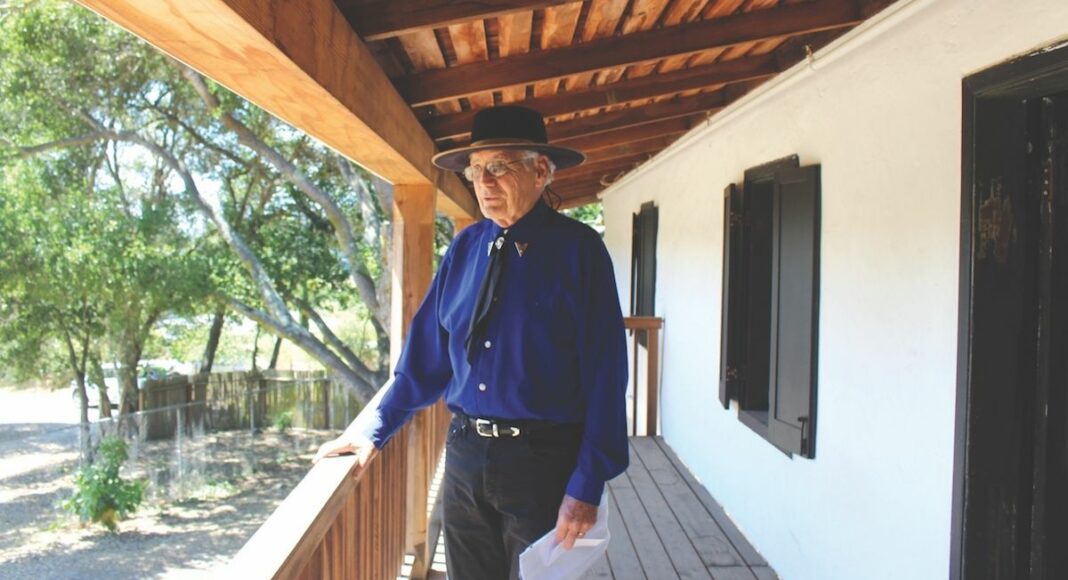WATSONVILLE—After nearly two years of being closed to the public, Castro Adobe State Historic Park will once again invite people to come learn about an important part of California history.
Located on a hill off of Larkin Valley Road and overlooking the Pajaro Valley, Castro Adobe’s main draw is a historic, two-story hacienda built between 1848-49 by Juan Jose Castro, son of Jose Joaquin Castro (an original member of the Juan Bautista de Anza Expedition). It is one of the few adobes left in the Monterey Bay area.
The park closed for construction in 2019. Then the pandemic hit, for a time, keeping volunteers and docents from working, and barring visitors to many state parks in California.
But the adobe is back—and aiming to hold three separate tours this summer. Volunteers have been hard at work preparing, getting the grounds ready and making major headway on the restoration.
Charlie Kieffer, a long-time docent of Castro Adobe and direct descendant of the Castro family, admitted he never thought he’d see the day that restoration of the adobe would be underway—let alone this close to completed.
“It’s unbelievable. I didn’t think it was going to happen,” he said. “Honestly, I didn’t think I’d live long enough to see it happen. This is an incredible time.”
The restoration and designation of Castro Adobe as an official state park has been ongoing for decades. In 1996, then-current owners of the property, Edna and Joe Kimbro, launched the “Save the Castro” effort in hopes of preserving the notable site, which had been badly damaged by the 1989 Loma Prieta Earthquake.
In 2002, after six years of advocacy, it was acquired by California State Parks, and five years later the Friends of the Santa Cruz State Parks (Friends) began organizing volunteers to help restore the structure. Over time, more volunteers have joined in and the South County community has rallied to support the cause.
“We’ve had school children from Watsonville putting quarters, 50 cents into little envelopes, for this adobe,” Kieffer said. “This place means a lot to this community.”
Kieffer said that he hopes the park will become a “living museum,” with everything from tortilla making in the adobe’s restored cocina to cow-roping demonstrations. The adobe’s restored fandango room, gardens and more will be available for guests to tour—and possibly come for events.
Charlene Duval, a historical archivist and member of the Friends board and the Castro Committee, said she has been part of the restoration since the beginning.
“It’s been a long haul but really exciting,” she said. “Friends and State Parks have really worked together to make this happen.”
Duval has been in charge of compiling and organizing The Edna Kimbro Library and Archives, located in the Kimbro house a short walk up the hill from the adobe.
According to Paul Karz, an aide at Castro Adobe, it is one of the biggest adobe archives in Northern California.
“This is going to be a real place for people to come study the period—a cultural center,” he said.
The upcoming tours will be held June 27, July 25 and Aug. 22. The first tour is already full, but the July and August dates still have room for people to sign up.
Pre-registration, social distancing, and masks will be required for all guests. Parking is limited; carpooling is encouraged. Visit bit.ly/3h0xUlF to register.
“This project has been a major collaboration between Friends and State Parks,” Karz said. “It’s something that doesn’t happen in any of the other state parks … it’s a very unique experience.”
For Kieffer, the restoration is a personal milestone, and one he is eager to show visitors—and other Castro descendants.
“When other Castros come here … I’ve seen them get tears in their eyes,” he said. “There’s something really special about this adobe.”
You can learn more about the history and preservation of Castro Adobe at bit.ly/3wS22Xg.













